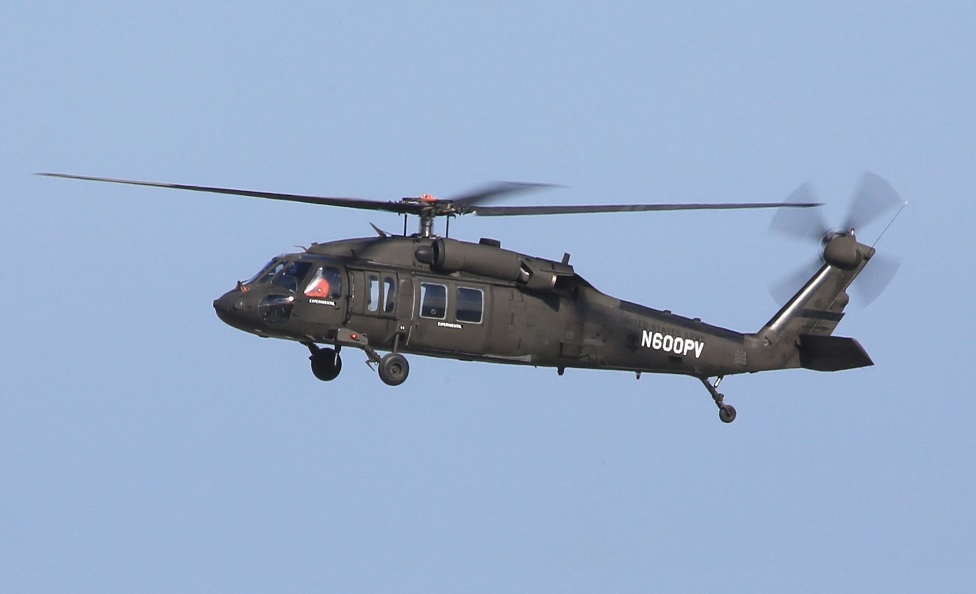Sikorsky says the optionally piloted vehicle (OPV) kit installed in the UH-60A Black Hawk that took flight last week is retrofittable, and hopes to see its future use expanded to other existing military and commercial product lines.

The kit sees the aircraft’s mechanical systems removed and replaced with full authority fly-by-wire controls and Matrix technology software.
The first flight of the OPV Black Hawk, completed at Sikorsky’s West Palm Beach, Florida, facility on May 29, marked the official start of a flight test program that will lead to fully autonomous flight of the aircraft in 2020.
In a conference call with reporters, Chris Van Buiten, vice president of Sikorsky innovations, said the event was “a historic flight for Sikorsky and perhaps for aviation,” marking the start of a journey to operations with two, one, or zero crew, depending on mission demands.
The piloted 0.9-hour first flight of the OPV system was completed by Sikorsky test pilot Mark Ward.
“The initial flight involved some basic hover work as well as some expansion to hover work up to about 40 knots,” he said, adding that there have been three subsequent flights. “Flight four had us going out to about 80 knots. We’re working on some datalink issues right now, but in terms of the aircraft itself, it’s performing very well.”
Developed through DARPA’s Aircrew Labor In-Cockpit Automation System (ALIAS) program, Sikorsky’s OPV approach aims to provide autonomy support during very complex missions with two crew, and enable reduced crew or unmanned flights when necessary.
The OPV is operated with a traditional-looking cyclic and collective controls. These are connected to the Matrix system, and it’s the aircraft’s computer that then drives the actuation.
“This system is flight critical, will be certifiable, so we are obviously careful with how we expand the envelope,” said Igor Cherepinsky, director of autonomy at Sikorsky.
Sikorsky has been developing the Matrix technology in the Sikorsky Autonomy Research Aircraft (SARA) — a modified S-76B — since 2013, recording more than 300 hours of autonomous flight. Cherepinsky explained that the difference between SARA and the OPV was that SARA retains mechanical flight controls. The Matrix system is in addition to those, and is simply engaged or disengaged to switch between autonomous and piloted flight.
The Army is also planning tests with an identical OPV kit, which it is installing on a UH-60M. It will begin flight tests with that aircraft in about six months, and the two programs will share data as testing progresses.
Van Buiten said the choice to install the kit in an A-model (which had been partially converted to an L-model) — one of the oldest Black Hawks — was deliberate. “We did that to show that we could retrofit any of the Black Hawks,” he said.
The kit will be retrofittable to UH-60 A, L, and M models, and possibly to other product lines, said Cherepinsky.
In March, Sikorsky announced an S-92 upgrade that includes the introduction of the first phase of Matrix technology. According to Sikorsky, it will enable adoption of autonomous landing technology.
For the time being, Sikorsky is continuing to expand the OPV Black Hawk’s flight envelope, and will be adding more software developed by SARA as testing continues.
When in operation, system functionality will continue to be added, said Cherepinsky. “As a baseline, what we intend to field immediately are the things we can demonstrate… which is handling all the contingencies, engines out, single-engine out, being able to autorotate, picking out its landing site and safely landing,” he said. “With that comes protection from controlled flight into terrain in degraded visual environments.”
The next step, which would happen soon afterwards, is allowing customers to decide whether they would like to fly certain missions with no-one on board.
In terms of its military applications, Van Buiten said the potential of the OPV technology to save lives was particularly promising.
“We’re going to get future flight crews that say, ‘It was a dark stormy night, all hell was breaking lose, and the autonomy system saved us,’ ” he said. “Or, we’re going to get a crew in the back of a helicopter that got shot up, lose the flight crew up front, and the helicopter saved all their lives, or pilot got injured in flight, became unconscious, and the helicopter delivered them to the MASH unit. It’s super exciting to me — part of the Sikorsky legacy of saving lives.”









